Evga Geforce Gtx 1080 Ti Sc2 Hybrid Review
At a Glance
Skilful's Rating
Pros
- Incredible gaming performance, even at 4K
- EVGA'due south iCX cooling keeps temperatures and dissonance low
- Smaller than other custom GTX 1080 Ti cards
Cons
- Shroud design may be divisive
Our Verdict
The GTX 1080 Ti SC2 uses EVGA's revolutionary iCX cooling engineering to make the most potent consumer graphics card in the world even better. It's cool, placidity, and powerful.
Best Prices Today

$
Ever since the monstrous $700 GeForce GTX 1080 Ti launched, the globe'southward been waiting to see what this beastly GPU was capable of in the hands of Nvidia'south hardware partners. The Founders Edition delivered damn near uncompromising sixty-fps performance at 4K resolution with everything cranked to 11, and that was with a lowly reference cooler and stock clock speeds. How far can factory-overclocked versions with potent custom cooling solutions go?
Well, for the beginning time ever, a graphics menu is so damn fast that it managed to largely push button a game's clogging off of the GPU and onto the CPU in PCWorld's ferocious testing PC—while running 15 degrees or more cooler than the Founders Edition.
And the EVGA GTX 1080 Ti SC2 ($720 preorder on Amazon) isn't even EVGA's fastest custom GTX 1080 Ti.
Damn.
Run across the EVGA GTX 1080 Ti SC2
Earlier nosotros dive into the customizations EVGA made to the SC2, hither's a refresher on the GTX 1080 Ti'due south default technical specs, built effectually the total-fatty version of Nvidia's GP102 graphics processor.
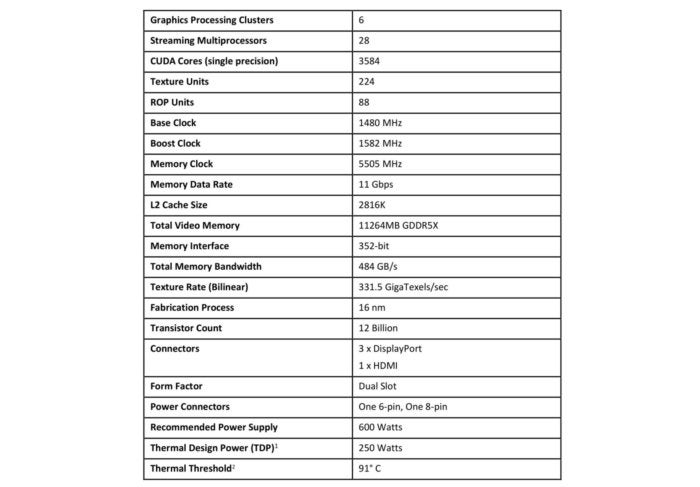 Nvidia
Nvidia The major deviation under the hood of EVGA's card is the GPU clock speed. The GTX 1080 Ti SC2 hums along at a 1,556MHz base clock and 1,670MHz heave clock. That'due south a healthy 88MHz leap over the GTX 1080 Ti Founders Edition boost clock—heck, the EVGA bill of fare's base clock is a mere 26MHz away from the stock version'due south boost clock. The numbers aren't every bit concrete as they seem, however, equally the GTX 1080 Ti regularly surpasses its rated heave clock anyway. Earlier performing whatsoever boosted overclocking, nosotros saw EVGA's carte striking clock speeds upwardly to one,850MHz in some games, depending on what was happening on-screen.
The memory'southward untouched compared to the reference version, with a borderline excessive 11GB of GDDR5X of onboard RAM. The cooling solution is anything merely.
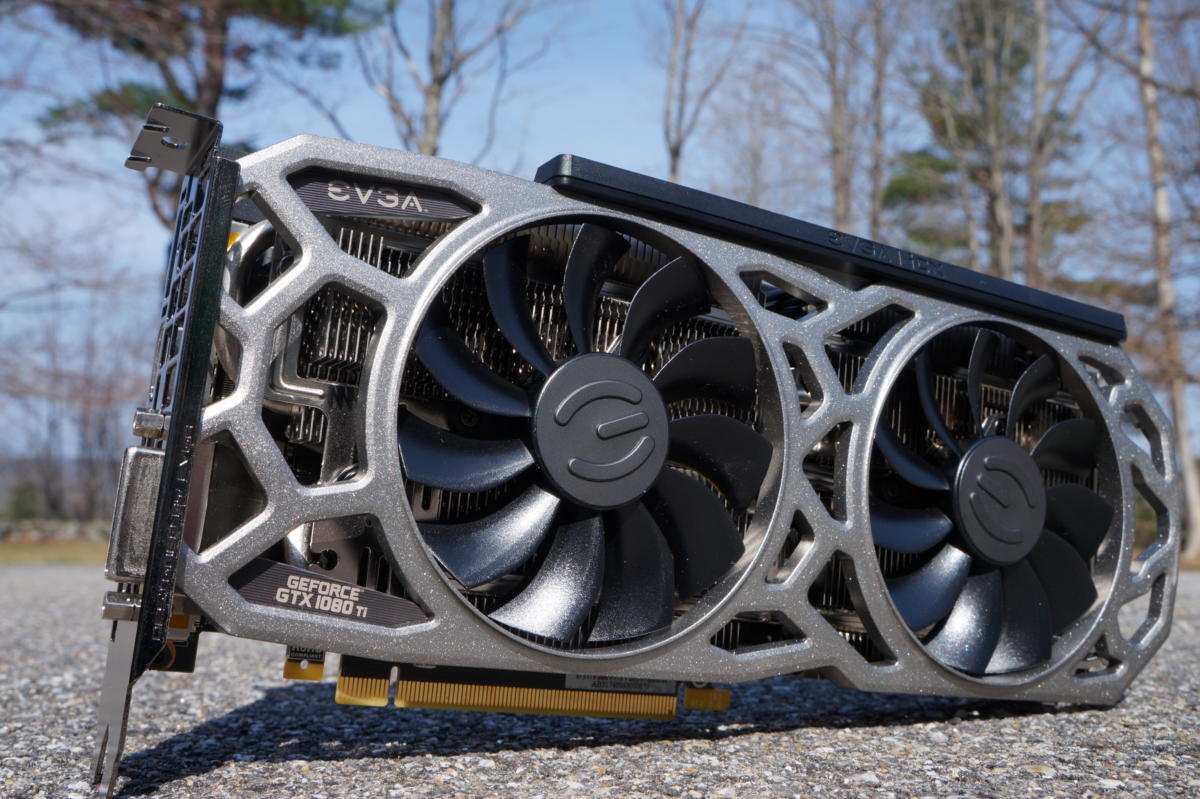 Brad Chacos/IDG
Brad Chacos/IDG You lot'll detect EVGA's new shroud blueprint first. With the GTX 1080 Ti lineup, the company'south ditched the solid exterior found in its customized GTX 1080 models for a porous new aesthetic that shows the beefy heatsink lurking underneath. The look's been somewhat divisive in forums but I dig it, non least of which because it shows the true star of the show here: EVGA's ambitious iCX cooling setup.
We went hands-on with EVGA's revolutionary iCX when information technology debuted in the GTX 1080 FTW2 before this year, and it's worth highlighting over again. Graphics cards have traditionally only featured a single temperature sensor, monitoring the GPU processor itself. EVGA's iCX loads the card with non one, non 2, merely nine boosted sensors that likewise monitors the rear of the GPU, the onboard memory modules, and the power controllers. Nigh every aspect of your graphics card is tracked.
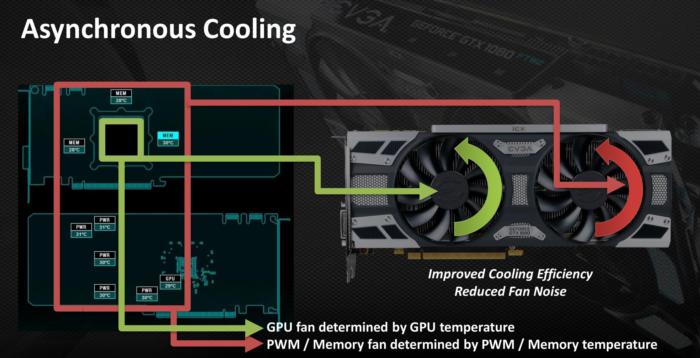 EVGA
EVGA How EVGA'due south iCX cooling technology works.
But iCX does more than simply track temperatures. Information technology uses that comprehensive data to command the speeds of the dual fans independently, with the leftmost fan responding to the GPU temperature, and the correct-side fan adjusting speeds to go along the memory and PWMs absurd. If the retention'southward heating upwardly rapidly merely the GPU itself is staying relatively cool, as can happen with the Furmark stress examination, the defended GPU fan maintains a slower, quieter speed, while the memory fan ramps up.
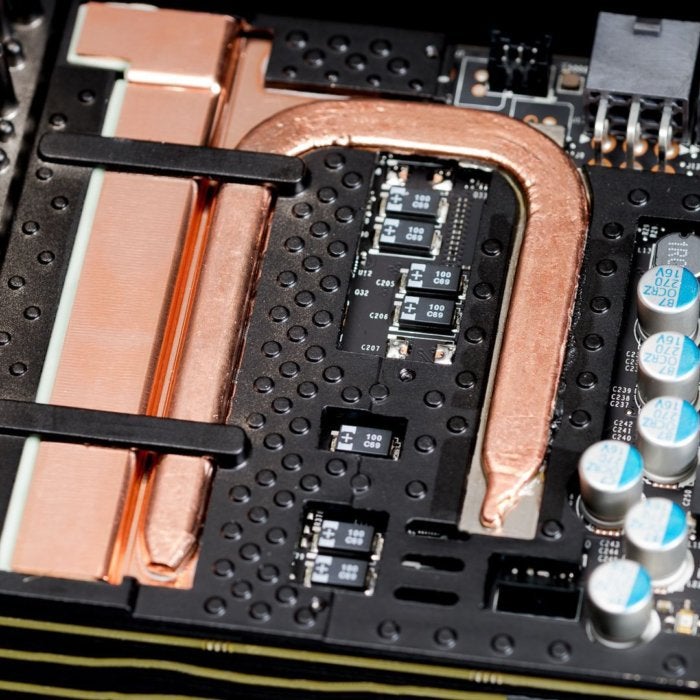 EVGA
EVGA The copper VRM heatpipe integrated in the GTX 1080 Ti's redesigned baseplate.
EVGA's tweaked the VRM heatpipe design on iCX-equipped GTX 1080 Ti cards too, to aid keep temperatures even lower.
Yous can monitor your temperatures sensor-by-sensor in EVGA'southward Precision XOC software, or just by glancing at the graphics carte in your example. 3 RGB lights higher up the EVGA GTX 1080 Ti SC2's logo on the card's edge indicate how hot your GPU, PWMs, and retentivity are, respectively. As components heat up, the individual lights modify color (not that y'all'll take to worry about information technology much with this bill of fare). Precision XOC lets you lot customize the colors of the EVGA logo also every bit the RGB indicators.
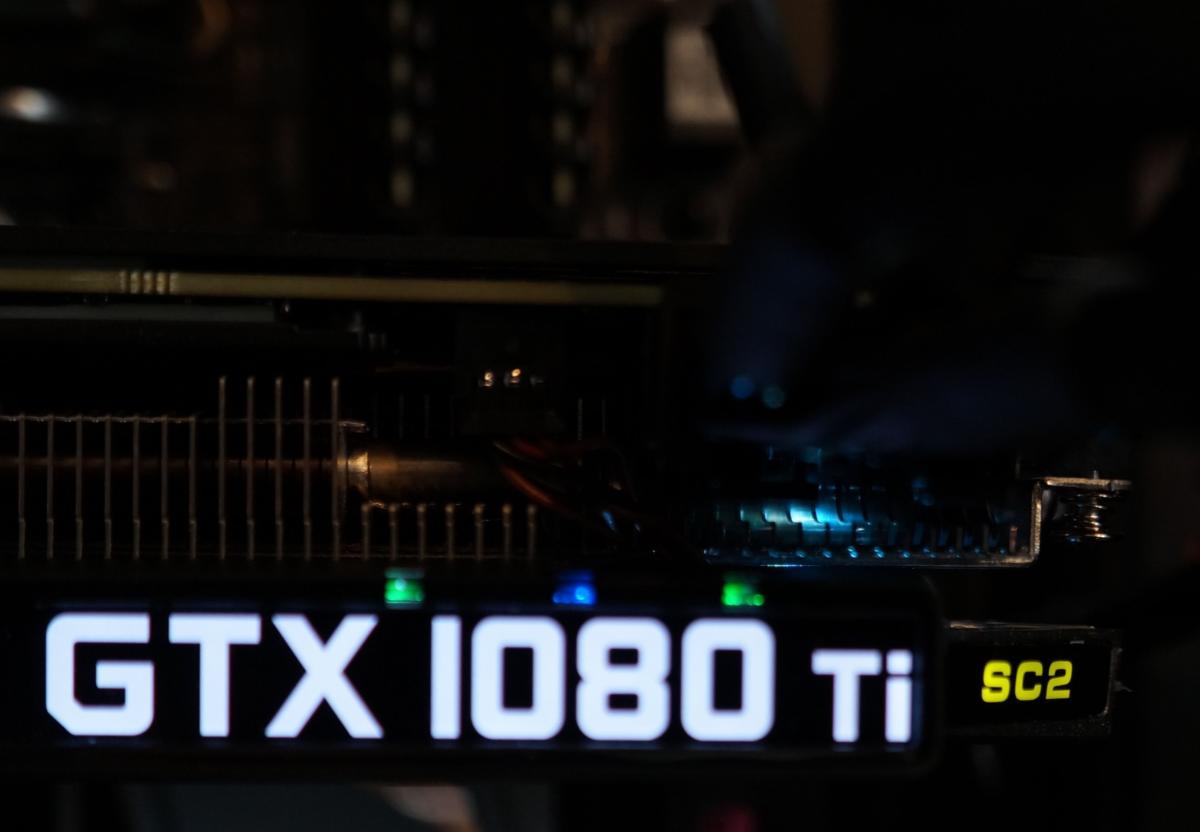 Brad Chacos/IDG
Brad Chacos/IDG The colored lights over the "1080" show how hot your hardware's running.
It feels like the hereafter of cooling, and it's stunningly constructive in exercise. It's overnice seeing RGB lights being used to practical furnishings, too. Most custom GTX 1080 Ti cards released thus far take used thicker 2.5- or 3-slot designs to go on the GPU tamed, but EVGA's card sticks to a traditional 2-slot size, and so it'll be interesting to meet how iCX holds up in games.
Equally far equally the rest of the card goes, the EVGA GTX 1080 Ti SC2 features a sturdy backplate, as you'd await in a graphics card this pricey. Despite its college clock speeds, the card withal harbors the same 250-watt TDP as the Founders Edition, and the same eight-pin and 6-pin ability connectors. EVGA's internal vii+two power phases will help you lot push the GPU to fifty-fifty faster speeds.
 Brad Chacos/IDG
Brad Chacos/IDG There's i terminal tweak of annotation. While Nvidia's GTX 1080 Ti Founders Edition ditched the DVI-D port to increase cooling while sticking to the same form factor as the GTX 1080 Founders Edition, EVGA'southward robust cooling arrangement allows the visitor to return the legacy, still well-loved connector to its rightful place on the rear of the carte.
Enough talk. Let's benchmark this badass. You're going to desire to read the results for heat and Ashes of the Singularity.
Next page: Organisation configuration, benchmarks begin
Our test system, Sectionalization benchmarks
We tested EVGA's GTX 1080 Ti SC2 on PCWorld's defended graphics card benchmark system. Our testbed'due south loaded with high-cease components to avert bottlenecks in other parts of the arrangement and prove unfettered graphics performance. At least, theoretically. Nosotros'll get to that later.
- Intel'southward Core i7-5960X with a Corsair Hydro Series H100i closed-loop h2o libation ($120 on Amazon).
- An Asus X99 Deluxe motherboard ($230 on Amazon for an updated version).
- Corsair'southward Vengeance LPX DDR4 memory ($130 on Amazon), and 1,200-watt AX1200i ability supply ($310 on Amazon).
- A 480GB Intel 730 series SSD ($280 on Amazon).
- Phanteks' Enthoo Evolv ATX instance ($190 on Amazon).
- Windows 10 Pro ($158 on Amazon).
Naturally, nosotros're comparing the EVGA GTX 1080 Ti SC2 against Nvidia'due south GTX 1080 Ti Founders Edition ($700 on Amazon). We already know that the GTX 1080 Ti stomps all rivals, but we're also including benchmarks from the Founders Edition GTX 1080 ($500 on Amazon) and GTX 1070 ($380 on Amazon) for reference. AMD hasn't had a competitive enthusiast-grade graphics card since Nvidia's GTX 10-series launched in mid-2016, and it won't until Radeon Vega hits the streets former before the end of June.
All cards are tested with default fan profiles and out-of-the-box clock speeds.
Each game'southward tested using its in-game benchmark at the mentioned graphics presets, with V-sync, frame charge per unit caps, and all GPU vendor-specific technologies—similar AMD TressFX, Nvidia GameWorks options, and FreeSync/G-Sync—disabled. This card is so powerful that we're limiting our testing to 4K and 2560×1440 resolution.
The Sectionalisation
The Partitioning, a gorgeous third-person shooter/RPG that mixes elements ofDestinyandGears of War, kicks things off with Ubisoft'southward new Snowdrop engine. Nosotros test the game in DirectX 11 mode; The Sectionalisation recently rolled out an update that adds DirectX 12 support, simply the performance is nearly identical to the DX11 results.
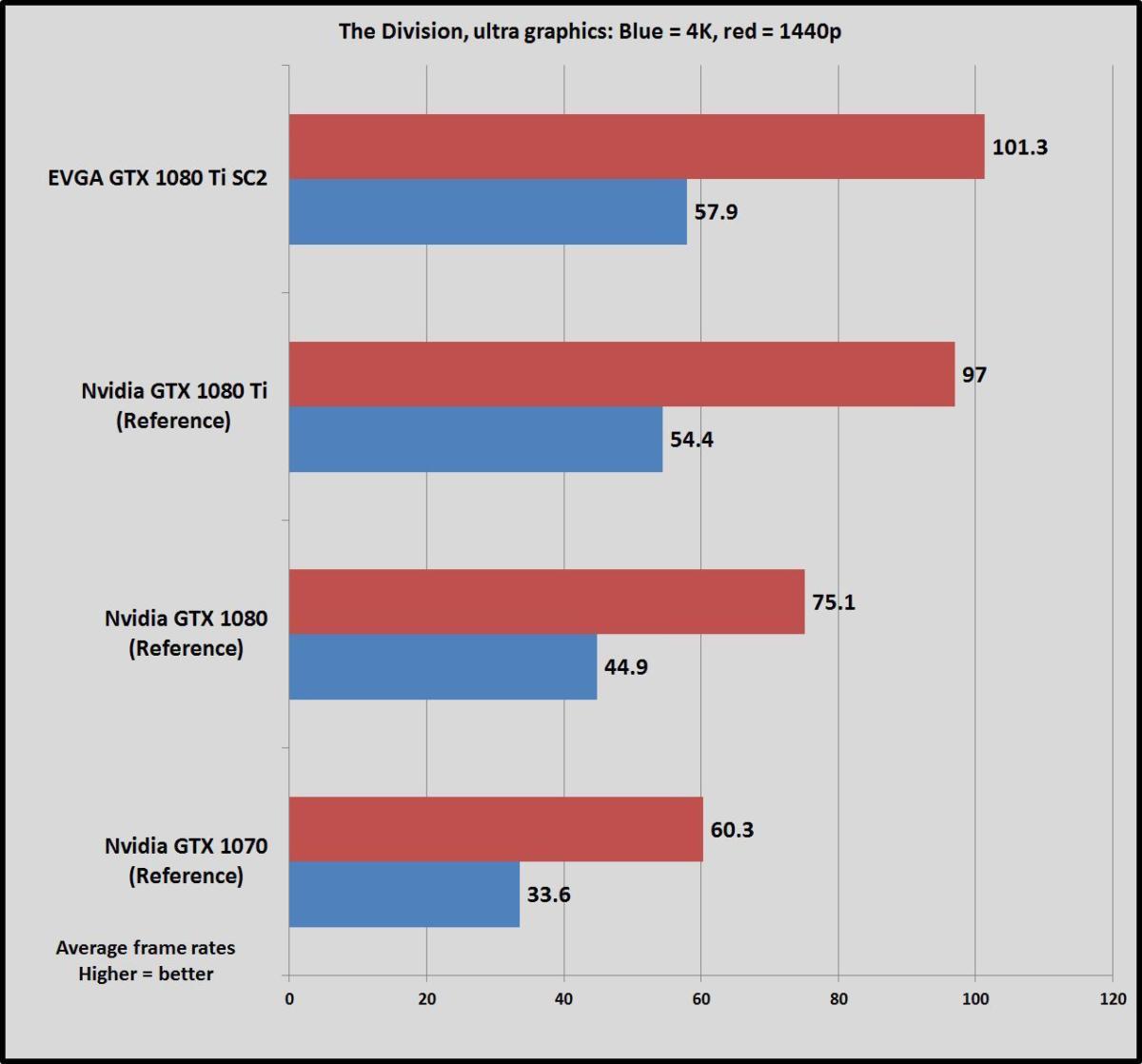 Brad Chacos/IDG
Brad Chacos/IDG The EVGA carte pushes a few more frames per second than the stock GTX 1080 Ti here, with a wider gap as resolution increases. Information technology pulls ahead by roughly 6.5 percent at 4K, only just iv.5 percent at 1440p.
Next page: Hitman
Hitman
Hitman'due south Glacier engine historically favored AMD hardware. Information technology's no surprise;Hitman'southward a flagship AMD Gaming Evolved title. That said, GeForce cards certainly don't slouch after recent commuter optimizations. We exam in both DirectX 11 and DirectX 12 with SSAO disabled.
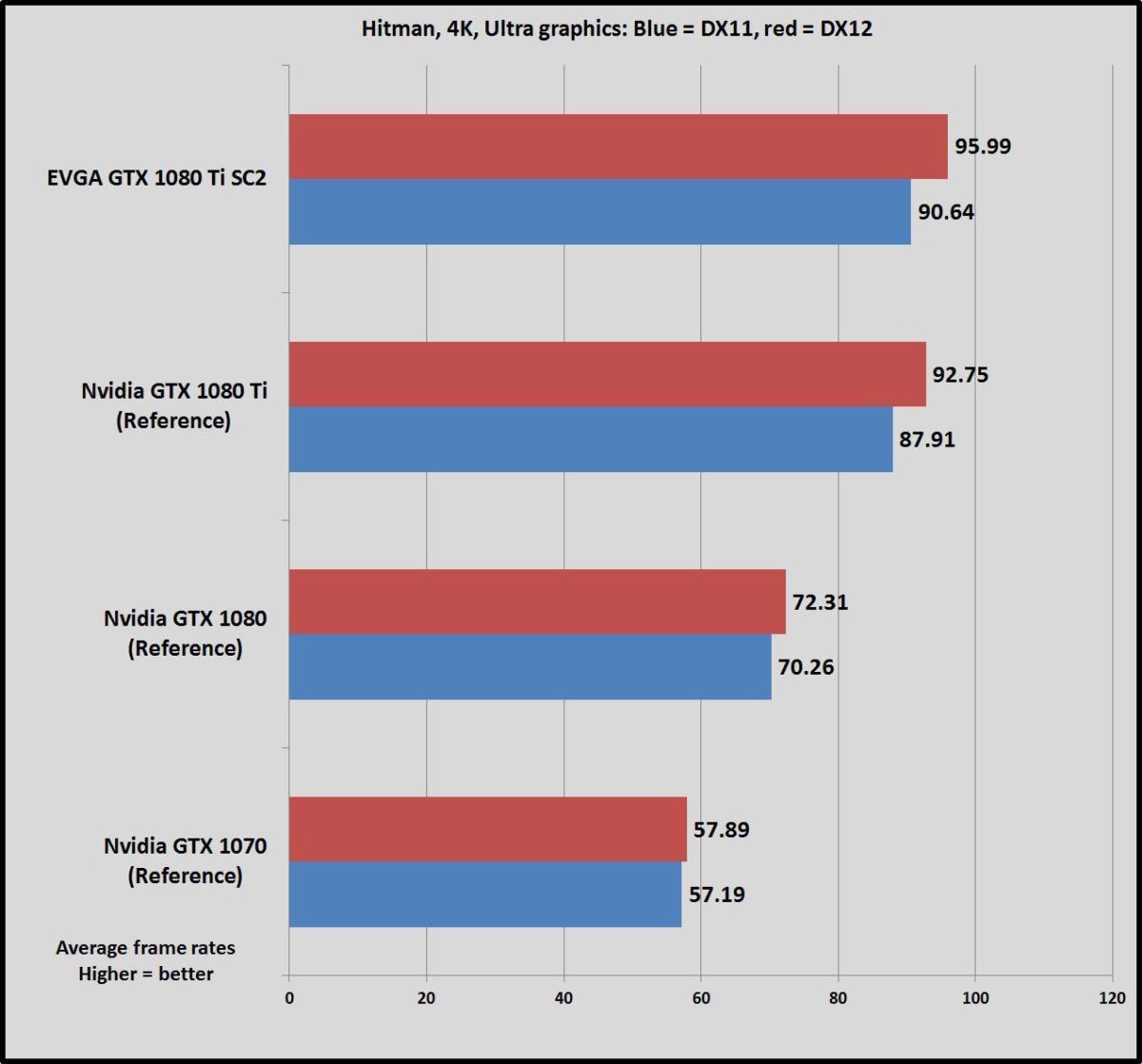 Brad Chacos/IDG
Brad Chacos/IDG 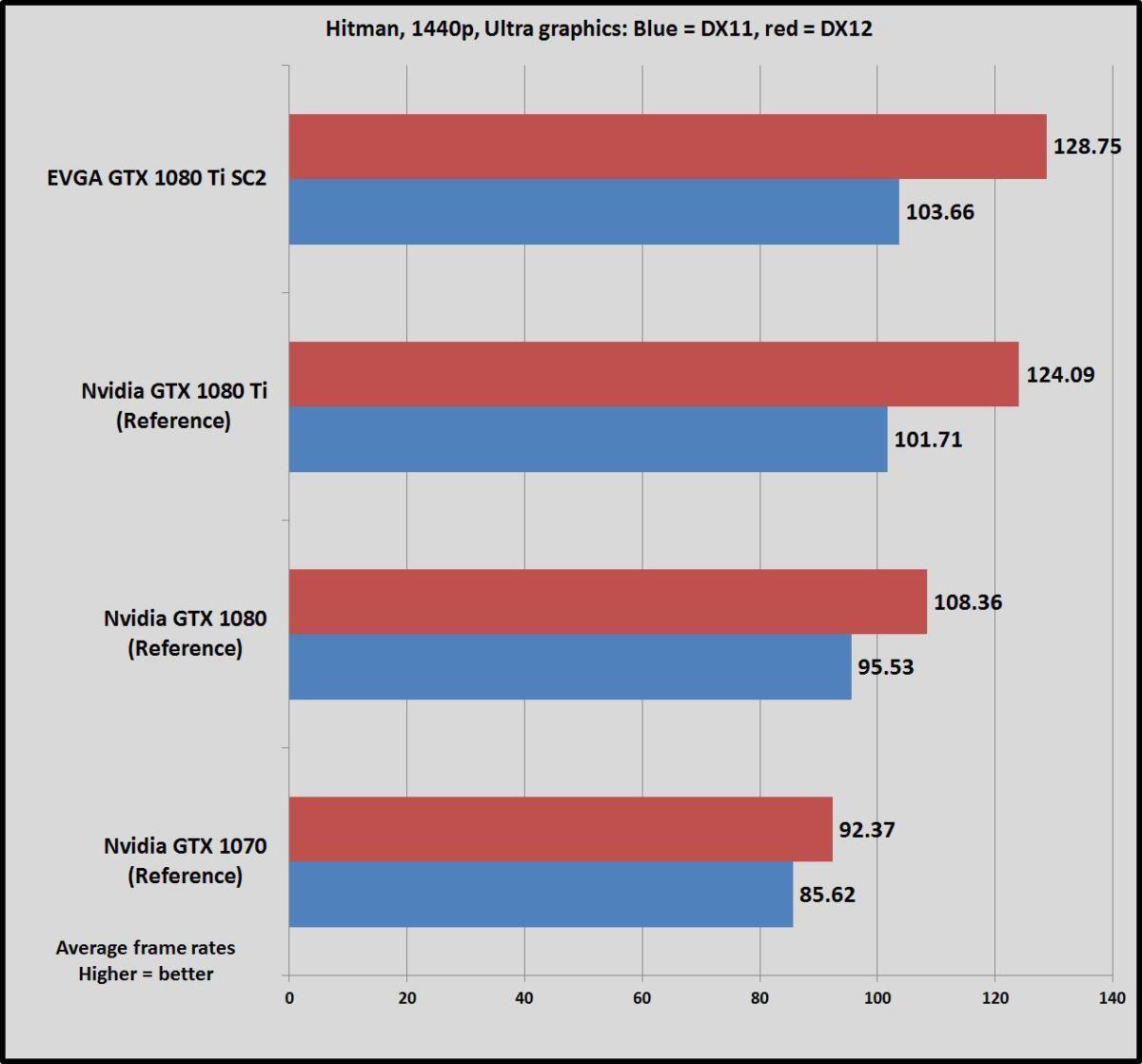 Brad Chacos/IDG
Brad Chacos/IDG The EVGA GTX 1080 Ti SC2's pb is less here, maybe because Hitman's already pushing out so many frames. We saw roughly 3 to 4 pct performance improvements over the GTX 1080 Ti Founders Edition at stock clock speeds—simply a lot of people don't buy a card like this to stick to stock speeds.
Next page: Rise of the Tomb Raider
Rise of the Tomb Raider
WhereasHitmanleans towards Radeon GPUs,Rise of the Tomb Raiderperforms much ameliorate on GeForce cards—and it'due south absolutely gorgeous. We just examination the game'southward DirectX 11 style, as DX12 results can be erratic.
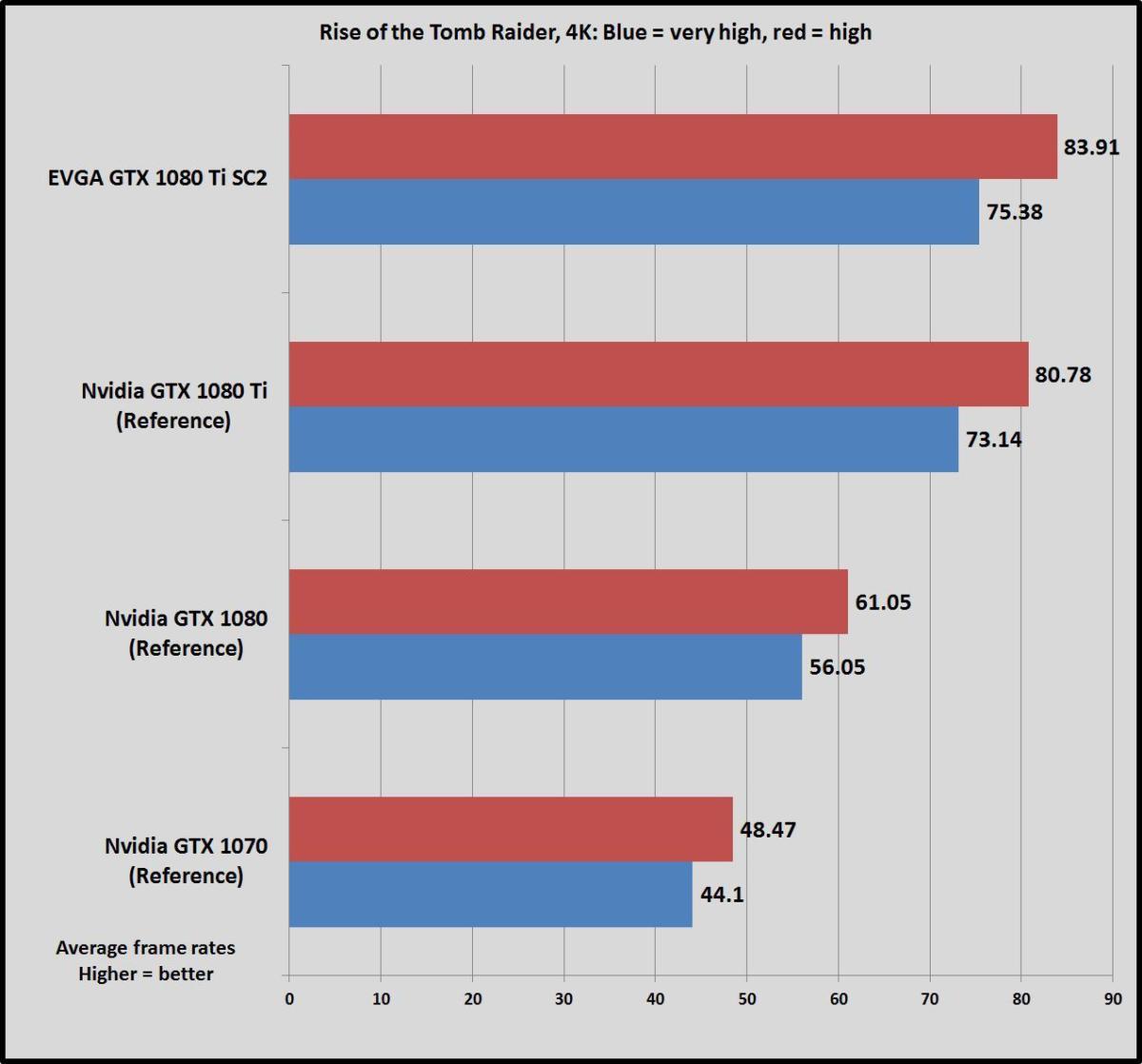 Brad Chacos/IDG
Brad Chacos/IDG 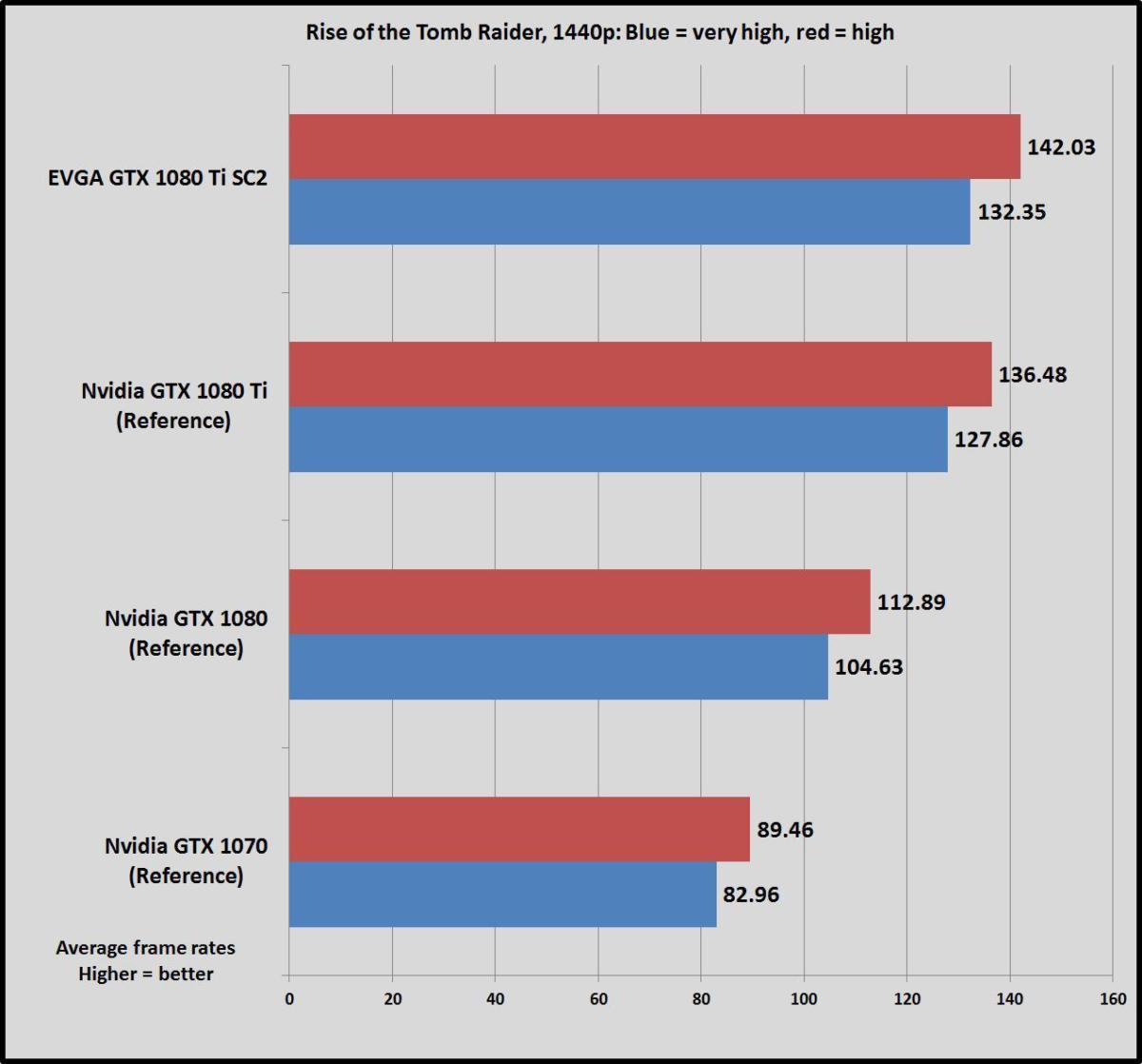 Brad Chacos/IDG
Brad Chacos/IDG Again, we saw a 3 to four percent comeback beyond the lath going from the Founders Edition to the EVGA GTX 1080 Ti SC2.
Next page: Far Cry Primal
Far Weep Primal
Far Cry Cardinalis another Ubisoft game, just information technology'due south powered past a different engine than The Division—the latest version of the long-running and well-respected Dunia engine.
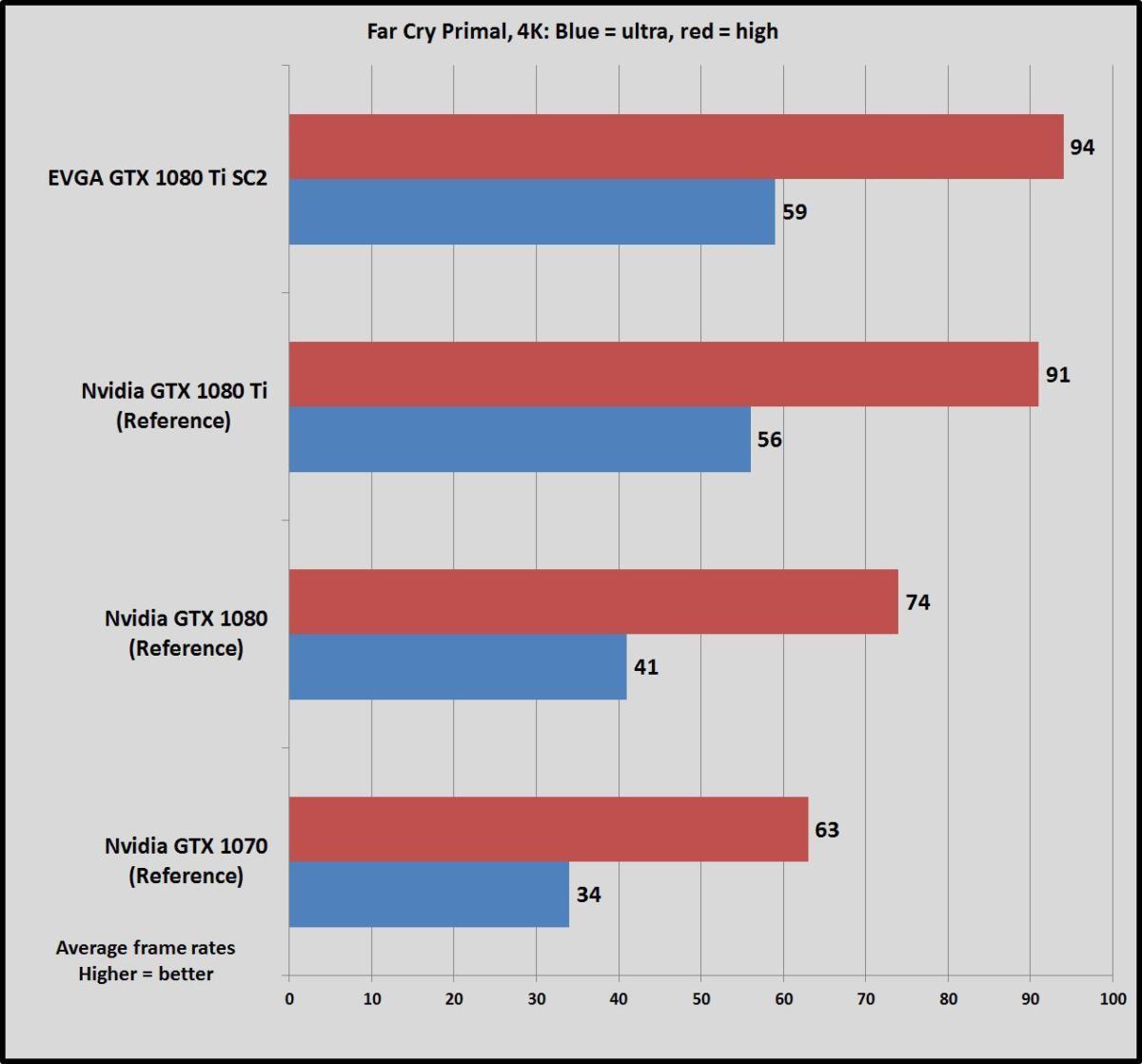 Brad Chacos/IDG
Brad Chacos/IDG  Brad Chacos/IDG
Brad Chacos/IDG Another game, some other improvement of a few frames per second over the stock GTX 1080 Ti. At 4K/Ultra, the difference is 5.36 percent.
Adjacent folio: Ashes of the Singularity
Ashes of the Singularity
Ashes of the Singularity, running on Oxide's custom Nitrous engine, was an early standard-bearer for DirectX 12, and many months after it'snevertheless the premier game for seeing what next-gen graphics technologies have to offering. We test the game using the High graphics setting, every bit the wildly strenuous Crazy and Extreme presets aren't cogitating of real-world usage scenarios.
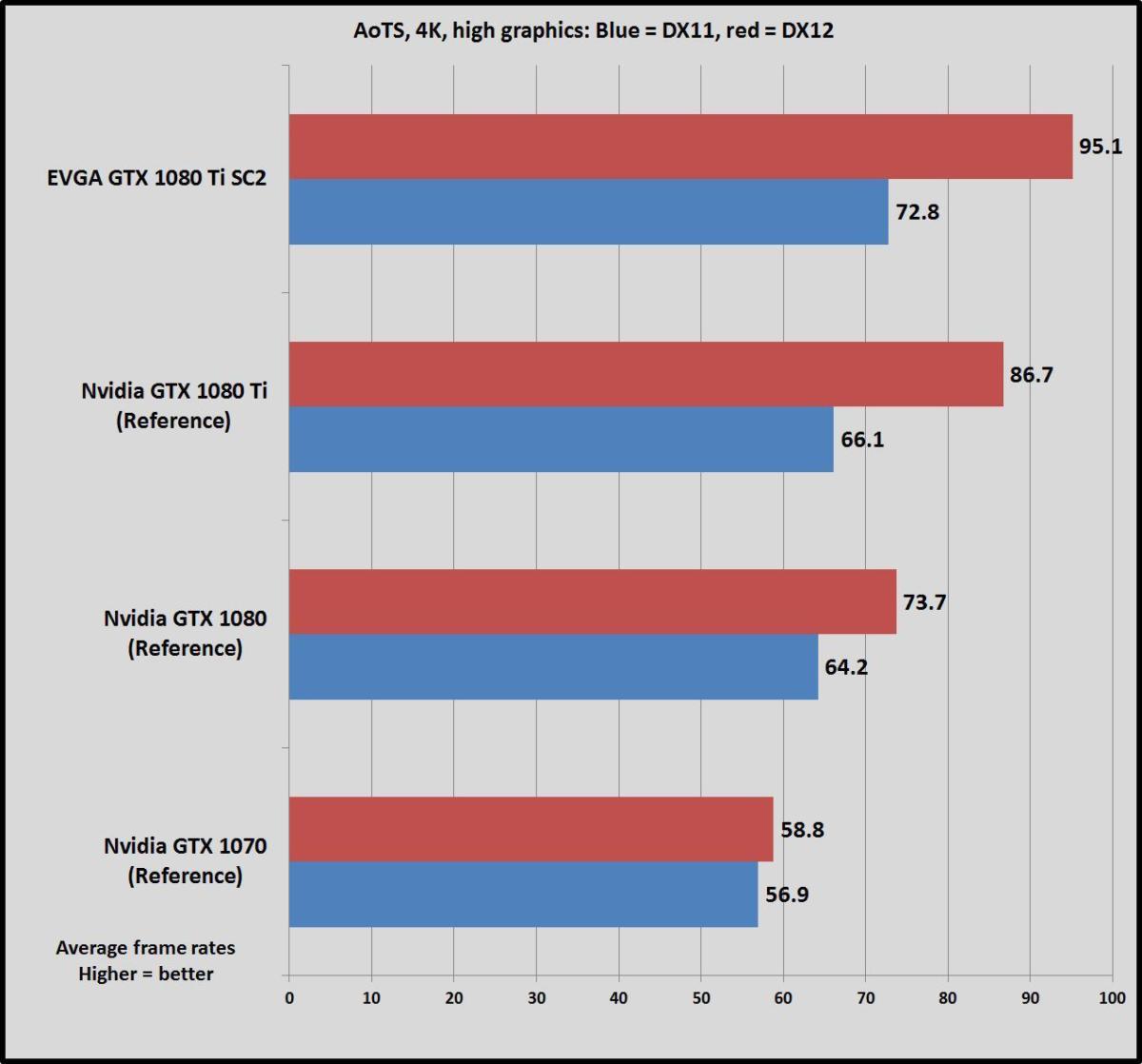 Brad Chacos/IDG
Brad Chacos/IDG 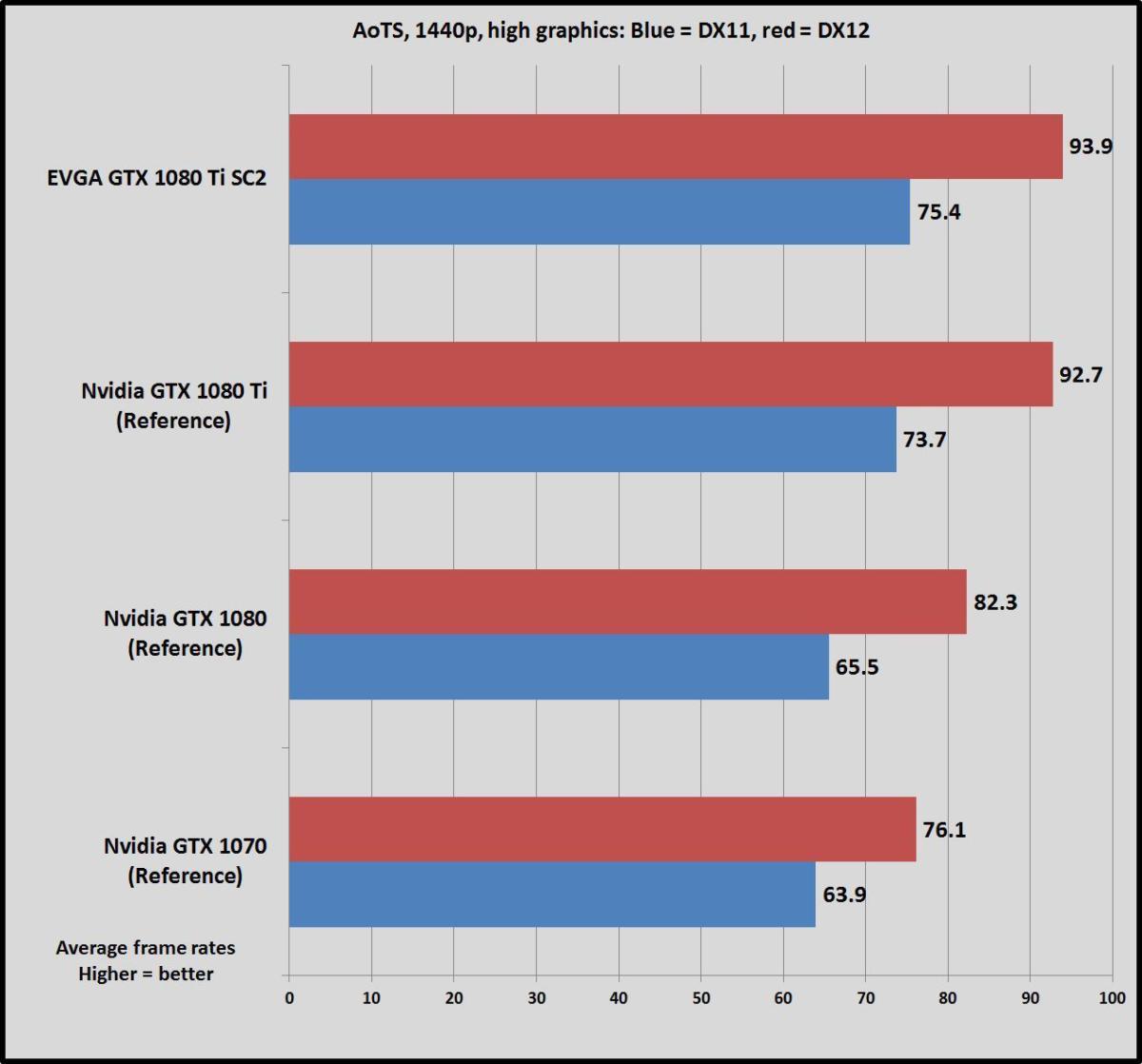 Brad Chacos/IDG
Brad Chacos/IDG Hither's where things get really interesting. The EVGA GTX 1080 Ti SC2 sees the biggest performance uptick of all the tests in Ashes, pushing out frames a total ten percent faster than the Founders Edition at 4K resolution. Just expect at those 1440p results! They're about identical between the 2 cards, and remained so after several tests.
That's considering the EVGA GTX 1080 Ti SC2 is and then fast, Ashes becomes CPU-leap rather than GPU-spring at 1440p/High—the first time we've seen a graphics card max out our system's capabilities. The SC2's extra oomph pushes it over the edge, equally confirmed by checking the game'south deeper metrics, which showed that only about 5 percent of heavy- and medium-batch frames were GPU-bound. To exist fair, the eight-cadre Cadre i7-5960X in our exam system runs at modest 3GHz stock speeds, merely it's even so a milestone. We'll exist making some changes before long to prevent it from happening again.
Adjacent page: Synthetic benchmarks
Synthetics, power, heat, overclocking
We also tested the EVGA GTX 1080 Ti SC2 and its rivals using 3DMark'due south highly respected DX11 Fire Strike and Fire Strike Ultra synthetic benchmarks, likewise as 3DMark's Fourth dimension Spy benchmark, which tests DirectX 12 performance at 2560×1440 resolution.
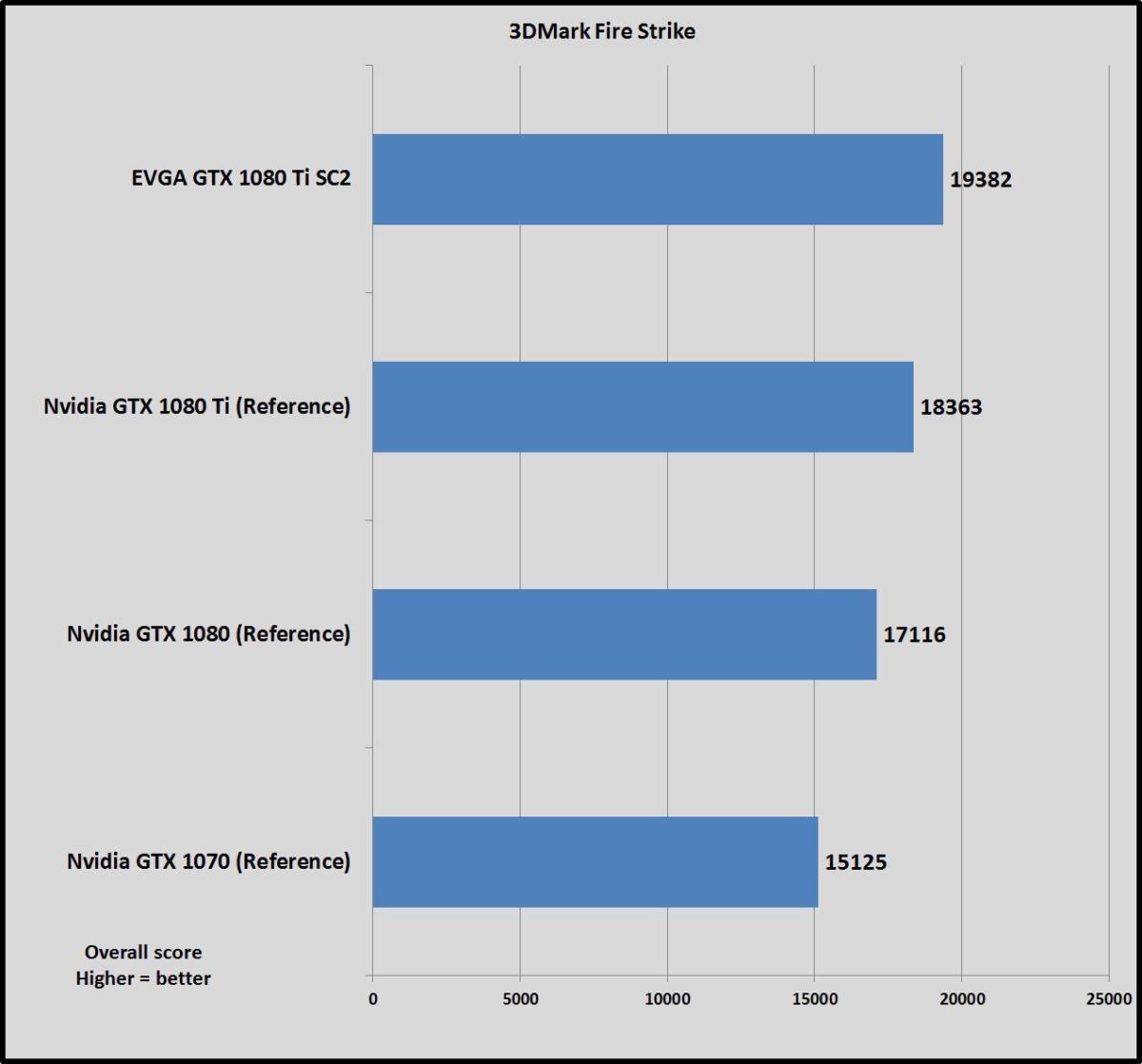 Brad Chacos/IDG
Brad Chacos/IDG 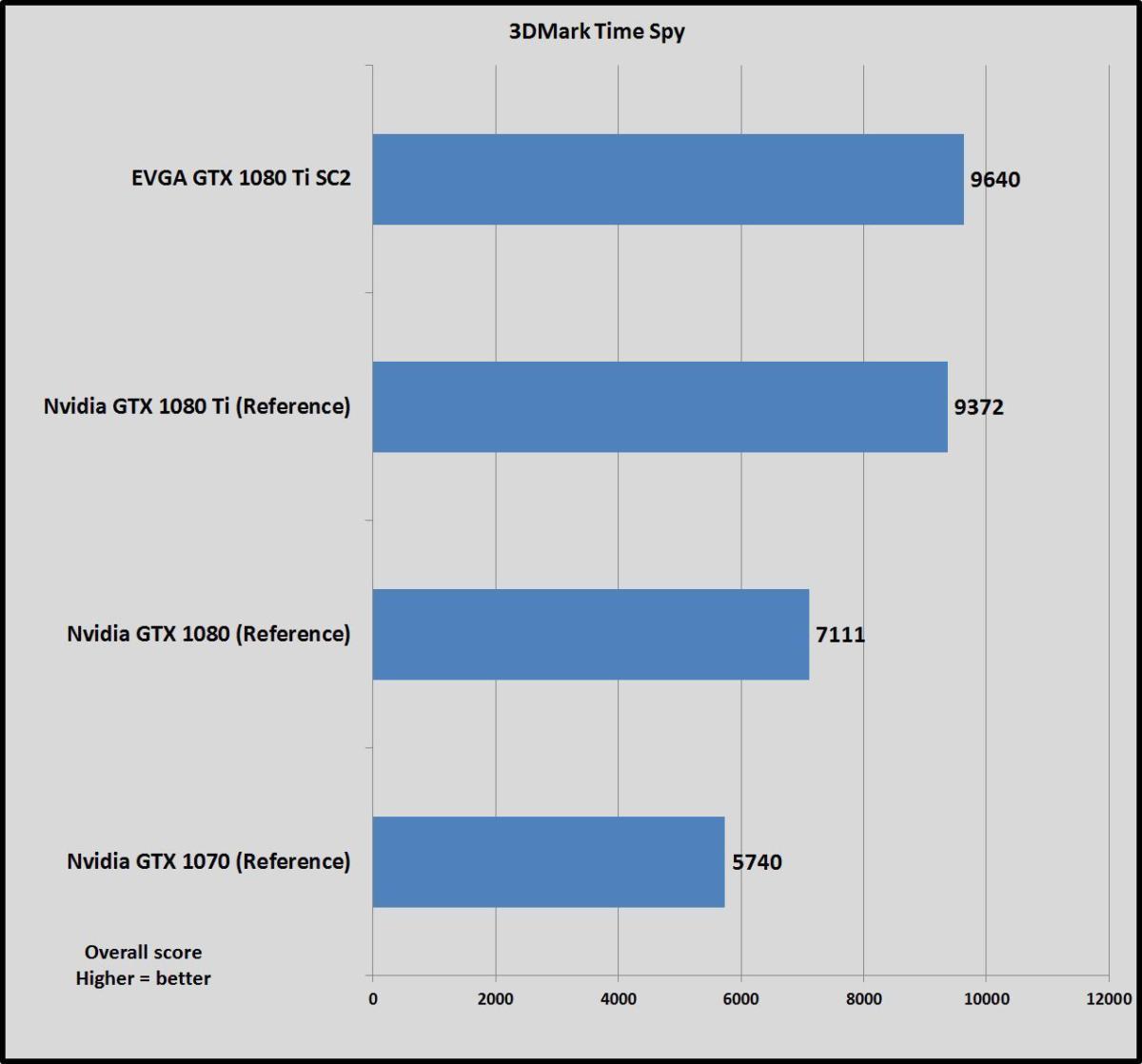 Brad Chacos/IDG
Brad Chacos/IDG Everything falls well-nigh where y'all'd expect based on prior performance results.
Adjacent page: Power and heat
Ability
Nosotros examination ability under load by plugging the entire system into a Watts Up meter, running the intensiveDivision benchmark at 4K resolution, and noting the peak ability draw. Idle power is measured after sitting on the Windows desktop for three minutes with no extra programs or processes running.
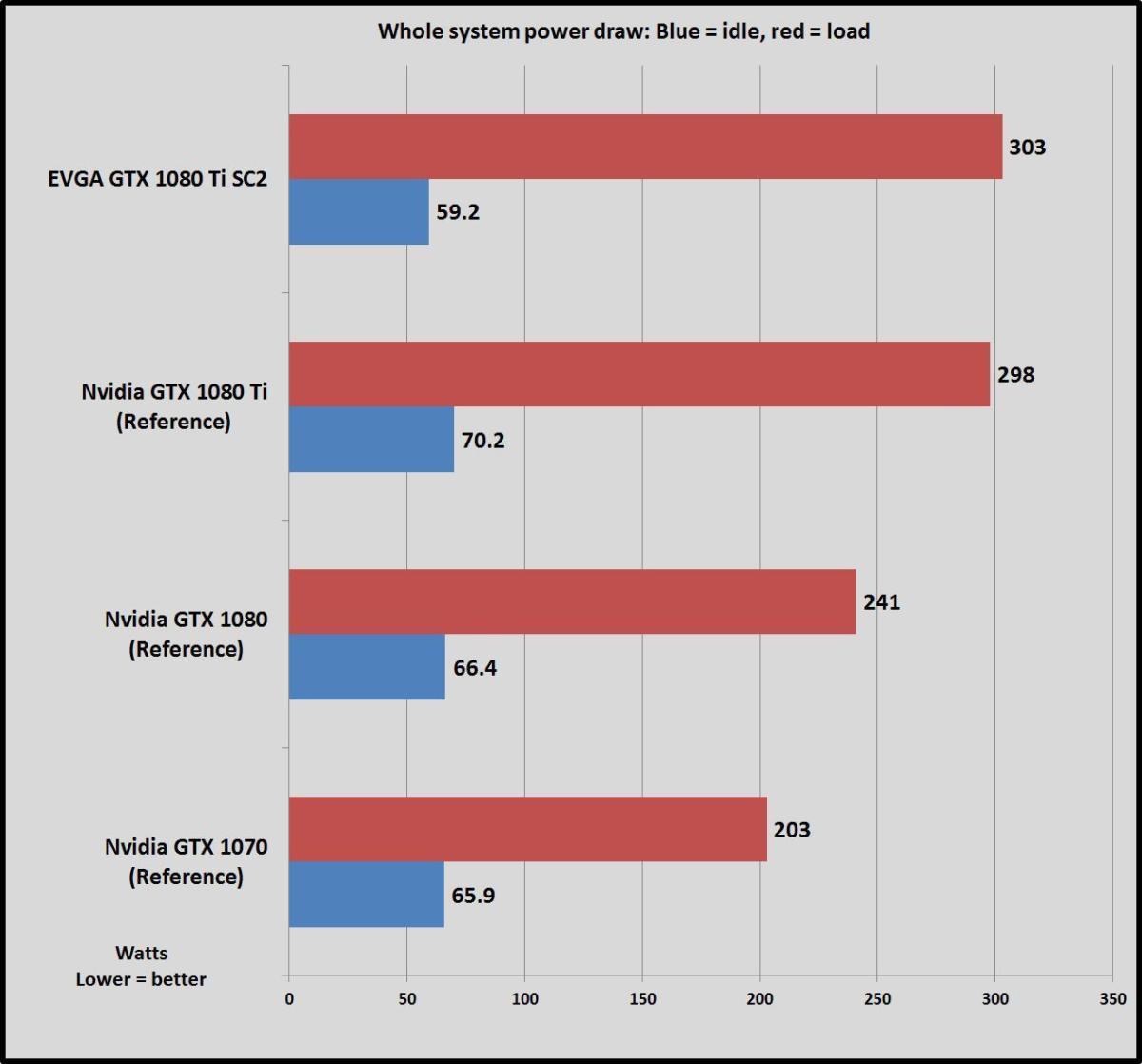 Brad Chacos/IDG
Brad Chacos/IDG The EVGA GTX 1080 Ti SC2 but uses a hair more ability than the GTX 1080 Ti Founders Edition, and a significant 10W less ability at idle. That's probably considering the dual fans on EVGA'south card stop spinning when the card isn't under load, whereas the reference model's fan constantly whirs.
Estrus
We test oestrus during the same intensiveDivision benchmark at a strenuous 4K resolution, by running SpeedFan in the background and noting the maximum GPU temperature (in Celsius) once the run is over.
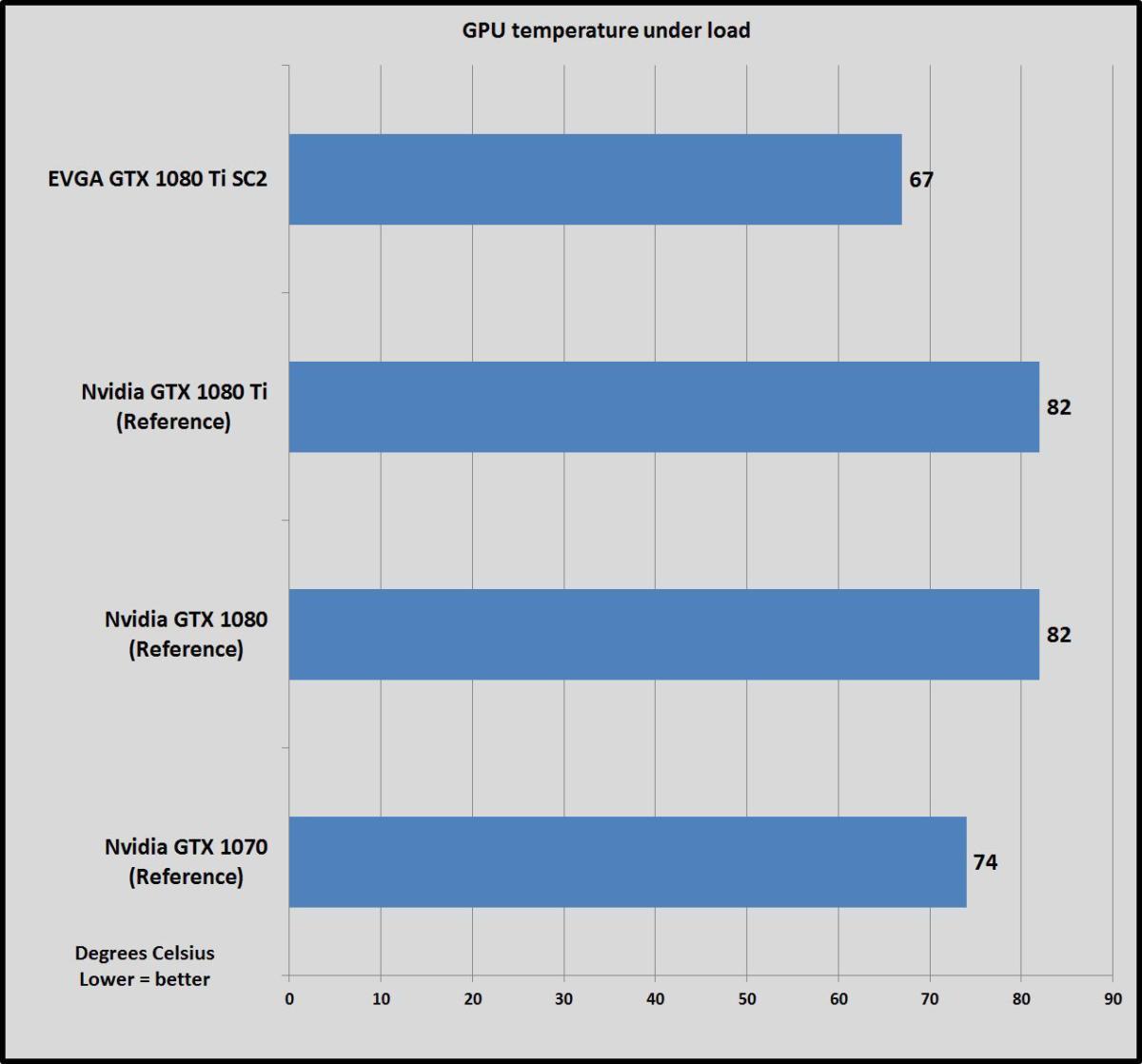 Brad Chacos/IDG
Brad Chacos/IDG The EVGA GTX 1080 Ti SC2's robust iCX cooling solution keeps the GPU a whopping 15 degrees Celsius cooler than the Founders Edition under load, and it stays far quieter while doing and so. Information technology's not merely the GPU staying chilly, either: Checks with Precision XOC showed the PWMs and memory running nice and absurd. I was hoping to snag a shot of the card clarion a scarlet RGB indicator light but couldn't get information technology to happen nether whatsoever reasonable circumstances, even subsequently overclocking.
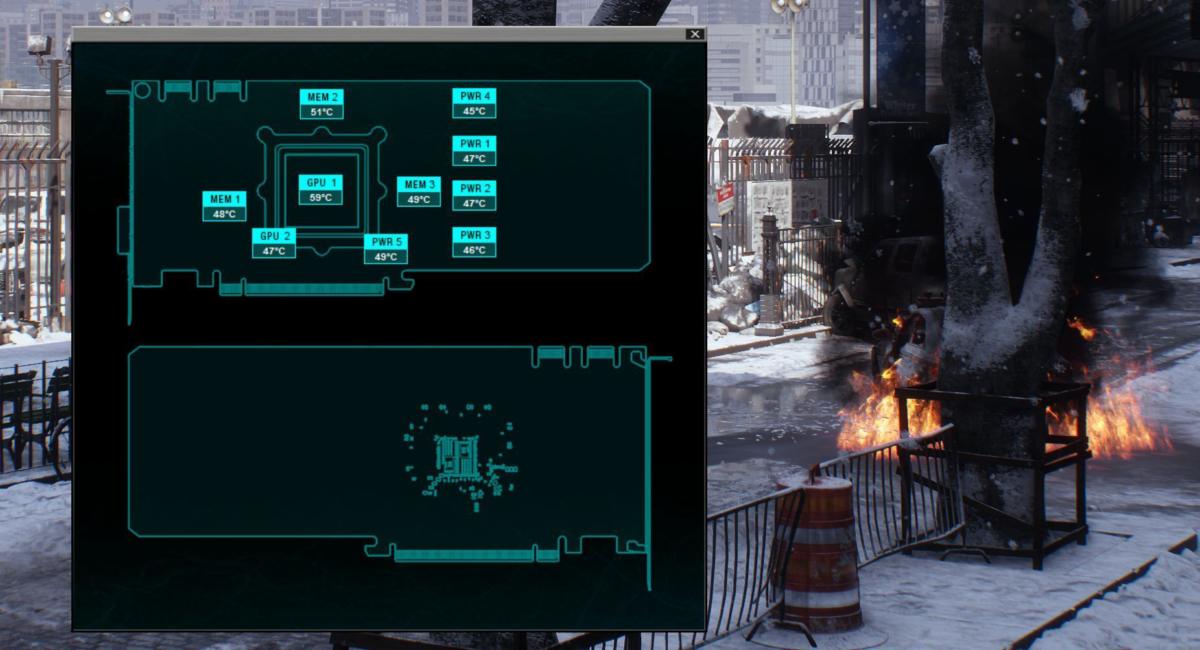 Brad Chacos/IDG
Brad Chacos/IDG Precison XOC's sensor temperature readings while running our thermal test, a.thousand.a.The Divisionat 4K repeatedly. (Click to enlarge.)
That'south using the default fan curve, besides. Precision XOC allows y'all to set a custom fan curve, or enable an "aggressive" fan curve. The ambitious curve, which I used in my overclocking endeavors, is no joke: It kept the overclocked GPU running betwixt 52 and 59 degrees Celsius in The Partitioning and Rise of the Tomb Raider even at 4K/Ultra. Air-cooled graphics cards don't get much colder than that—though the fan noise generated using that setting is simply as ambitious.
Next page: Overclocking and bottom line
Overclocking
Unfortunately, time constraints prevented me from fine-tuning the perfect overclock with the EVGA GTX 1080 Ti SC2. Without tweaking the ability limit—an important annotation—I was able to achieve a +80MHz showtime on the card's GPU clocks, which resulted in bodily clock speeds of one,910MHz to one,987MHz in games depending on the resolution and intensity of the scene. Memory overclocks hit +300MHz without a hitch, and could've gone further if I had time to keep stepping up the frequency and checking stability.
Even overclocked, EVGA'due south aggressive fan curve kept temperatures in the mid- to loftier-50s, Celsius. The combination of the overclock and using the ambitious fan curve besides didn't apply much more ability than the stock configuration, at 314W instead of 303W.
This hasty overclock added a few more frames' worth of functioning in the scattering of games I was able to test at 4K/Ultra.
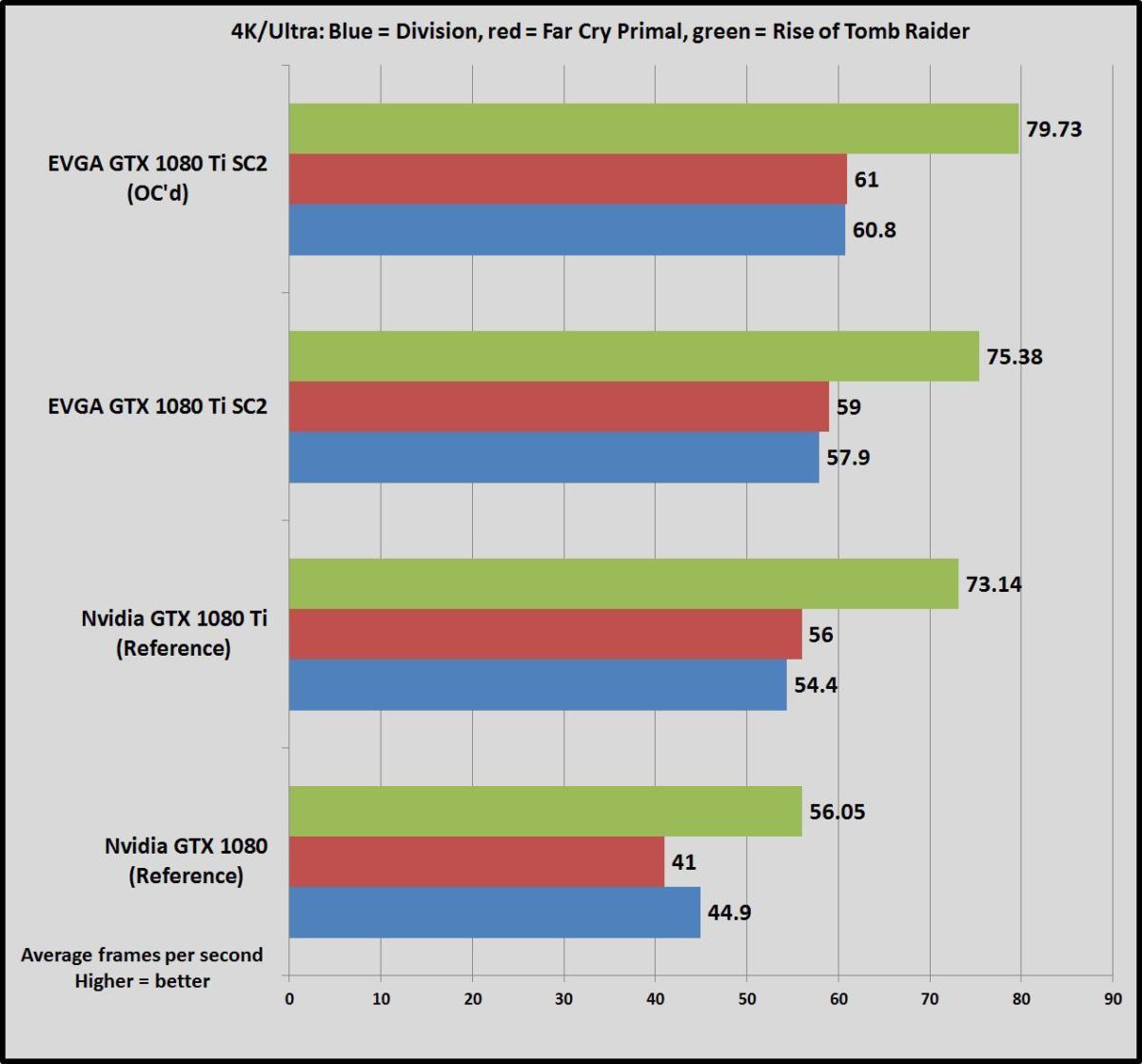 Brad Chacos/IDG
Brad Chacos/IDG Brief overclocking results.
The extra oomph provided past the overclock resulted in a 9.9 percent average frame charge per unit increase compared to the stock GTX 1080 Ti Founders Edition, and no dubiety with time I could've pushed information technology even further. Not too shabby.
Oh, and I tested Ashes of the Singularity at 1440p with the overclocked EVGA SC2 and saw virtually no difference in performance yet again. Aye, information technology's CPU-bound.
Bottom line
The EVGA GTX 1080 Ti SC2 kicks ass.
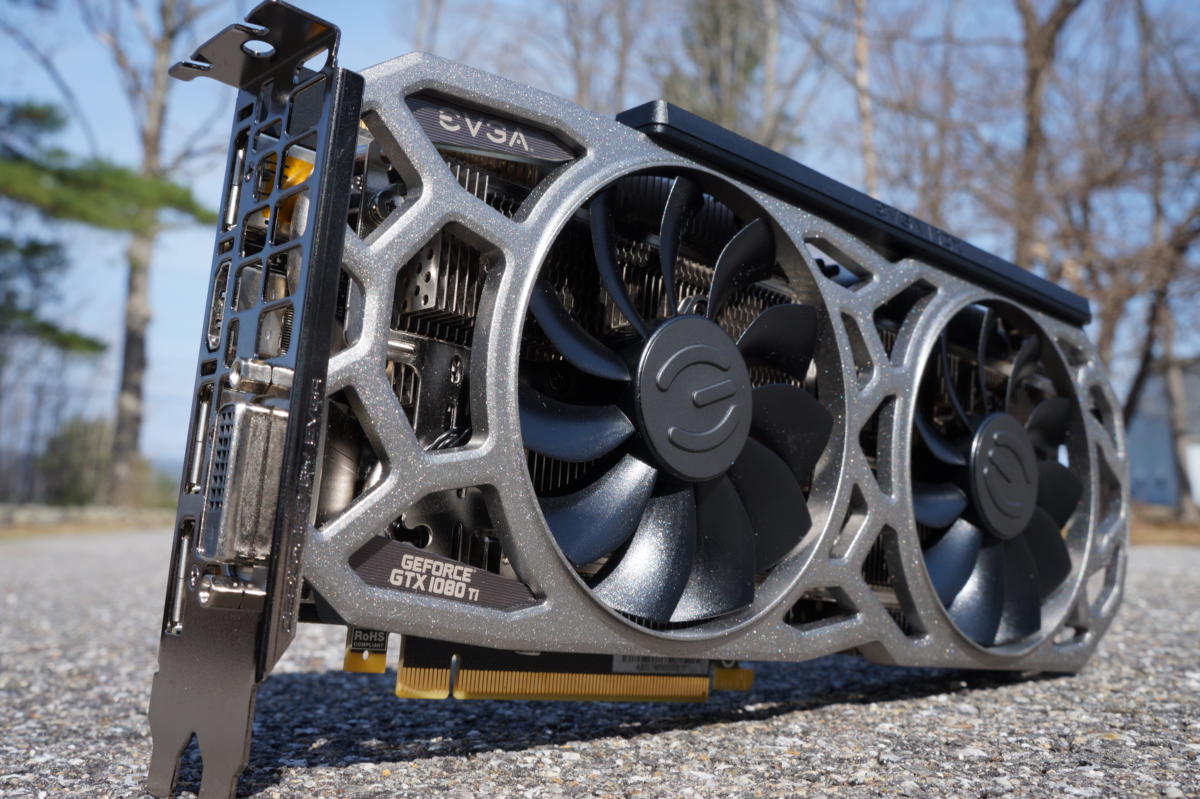 Brad Chacos/IDG
Brad Chacos/IDG Sure, it's just an average of v.seven percentage faster than the GTX 1080 Ti Founders Edition out of the box, just fifty-fifty that small increase is enough to push button The Division and Far Cry Key to the edge of 60 fps at 4K resolution with all the graphics options cranked to eleven—and push Ashes of the Singularity into being CPU-bound at 1440p. A quick, basic overclock nearly doubled the performance proceeds, though overclocking's always subject to the whims of the silicon lottery.
The existent star here is EVGA'south unique iCX cooling solution. I was a fan (har har) when EVGA debuted iCX, and the refinements in the GTX 1080 Ti SC2 really get in smoothen. The bill of fare runs cool as a cucumber and quiet as a mouse with its default fan contour, and that's all the more impressive when you consider that the EVGA GTX 1080 Ti SC2's a standard two-slot size. Near of the other custom GTX 1080 Ti cards released expanded to bulkier two.5- and iii-slot thicknesses to adjust the heat of this potent GPU.
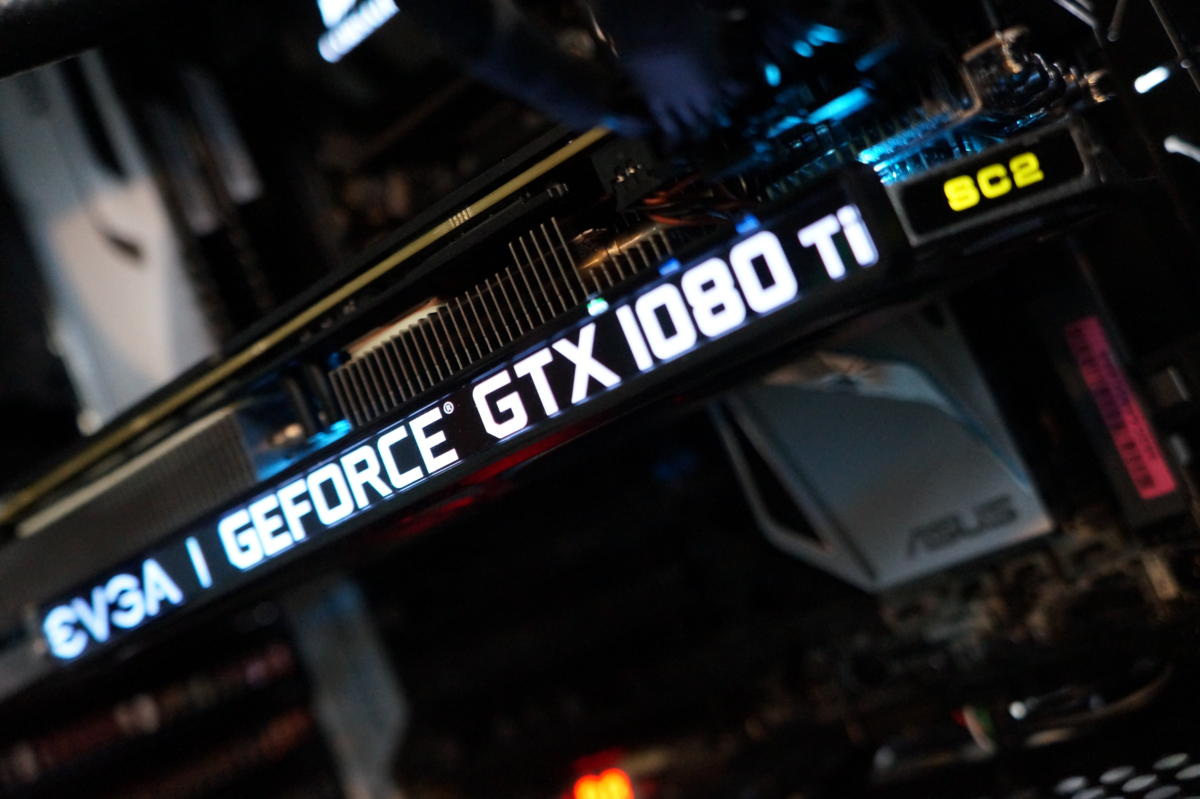 Brad Chacos/IDG
Brad Chacos/IDG If you're actually looking to crank overclocks every bit far every bit possible, you might want to wait for the release of EVGA's flagship GTX 1080 Ti FTW3 flagship, which is also imbued with iCX. That carte offers slightly college out-of-the-clock speeds merely really caters to overclockers past swapping out the secondary 6-pin power connector with another 8-pin connector, upgrading the power phases to a 10+2 arrangement, and adding a second BIOS. It costs $30 more, though.
You lot can't be disappointed with a cool, placidity, eminently configurable graphics menu that pushes performance to the literal brink in a game like Ashes, though. The GTX 1080 Ti SC2'south performance bump and vastly improved cooling solution make it well worth the $20 premium over a Founders Edition card. EVGA'south card is easily the fastest graphics card to ever cross our labs. Don't hesitate to buy information technology if you're gaming at 4K resolution, or 1440p at a high refresh rate.
And we won't hesitate to upgrade our testing system. Look for a rebuild before Radeon Vega lands, consummate with a new lineup of game benchmarks.
Notation: When y'all purchase something after clicking links in our articles, we may earn a small-scale commission. Read our affiliate link policy for more details.
Source: https://www.pcworld.com/article/406500/evga-gtx-1080-ti-sc2-review-a-ferocious-graphics-card-with-a-radical-cooler.html
0 Response to "Evga Geforce Gtx 1080 Ti Sc2 Hybrid Review"
Post a Comment